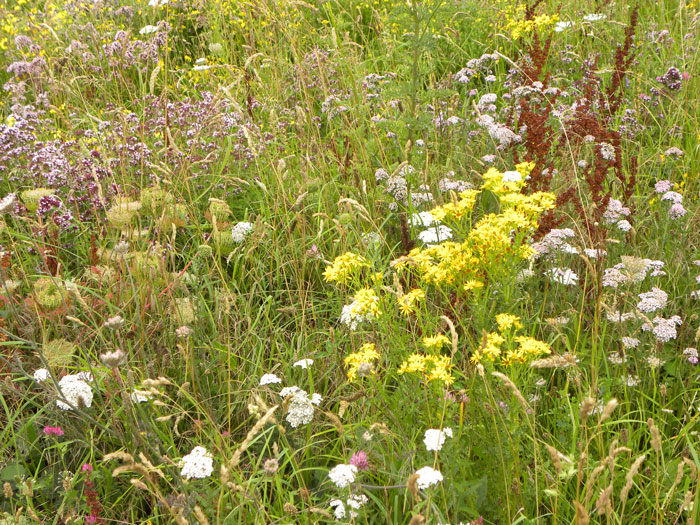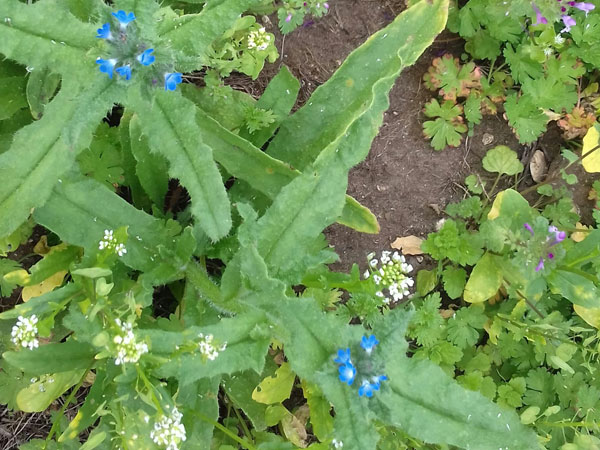Peddars Meadow
A thought begins… a plan is made…
The Making of Peddars Meadow

Member of Peddars Meadow Group inspects neighbouring meadow with some degree of envy!
Step one: To release an acre of land from agricultural use. Follow guidance to restore the land from the ground up and enable the return of flora and fauna once abundant here.
Step two: To raise funds to pay for land rent/or farmer for loss of crop/ mowing etc.
Step three: Publicise our efforts and encourage twinning with like-minded villagers across the land: we have approximately 30,000 villages in England.
Rationale:
To improve the habitat for insects and pollinators. To bring wildflowers back from the brink and to make this land whole again: an acre per village, beginning with our own village of Ringstead, West Norfolk.

What we strive for… field edging showing marjoram, wild carrot, yarrow, clover etc.
What we did:
In March 2020, we formed a small but efficient group of like-minded villagers and rented ½ acre of land from our local landowner adjacent to Peddars Way South. This was a start. The land lies beside a splendid wild flower area with which we hope to merge next year to form Peddars Meadow.
What we found:
In sharp contrast to our neighbour’s verdant field, the soil of our plot (to our inexpert eyes), looked structure-less and spongy. It lay part barren, part beneath a thick mat of bindweed. Two rows of straggly wallflowers were the only reminder that for 40 years this land had served a local nursery. Yet, after three years of rest, there was no noticeable recovery of native plants.
What to do?
Our group had no knowledge of soils, but we knew a farmer who did. He had created the adjacent flower-rich area. Against all principles of agriculture reversal, we decided, reluctantly, to follow his advice and apply a systemic herbicide to rid the ground of bindweed. This was carried out mid-April 2020, followed some weeks later by mowing and cultivating (tilling).

The patchy barren ground of Peddars Meadow pre cutivation (tilling).

Our farmer inspects the ground during cultivation.

After decades in the soil, bugloss seeds awaken.

A shiny new blanket of bugloss and fumitory July 2020.
The result was magical
Mid-July, twelve weeks after the herbicide was applied, gone was the barren ground and bindweed. We were standing before a magical shiny green blanket of bugloss and fumitory which had lain dormant in the soil for decades. We would now sit back and see what else would pop up. (Please note – We are fully aware of the conflict of using herbicide versus restoring a natural environment).
In the meanwhile:
Funds were needed…. Most villages are short of monies for other splendid needs and our village is no exception. With one foot in the art world, I decided to raise funds by indulging in a long-held ambition.
With the aid of a creative builder, our garage was converted and the Garage Studio was born. I appealed for artists and to my immense gratitude, attracted 16 wonderful Norfolk artists including a sculptor, a potter, a seamstress and the maker of lovely soaps.

Peddars Meadow – including adjacent area.
Where we are now:
The gallery opened quietly in August and is doing well. We have covered the cost of preparing Peddars Meadow. The weather has decided we should wait until spring before re-cultivating rather than attempt the autumn sowing we had planned for September.

Ringstead from Peddars Way South.
And just maybe…
reseeding won’t be necessary. Maybe the meadow will continue to delight and surprise. For now, the faded annuals will provide winter cover for hares and other fauna. Once established, our meadow will need little management. We have also erected an owl post from which our owls can peruse the ground for prey.
Our hope:
It is our ardent hope to increase our acreage to include field edging along Peddars Way South, thus forming a corridor to the neighbouring and wonderfully organic Courtyard Farm.

Seedhead of the wild carrot.
Into the future:
Could your village twin with us? Renting an acre of land directly from the farmer would cost approximately £300 per annum for loss of crop: not a huge amount to raise in return for giving nature a boost. The cost of reseeding, if necessary, will vary across the land. A tractor for annual mowing will depend on the friendliness of your farmer.
Do email me if you would like to do something similar where you live. We would be delighted to hear from you and share your ideas.
“This is such a simple and beautiful idea which would be exciting to see repeated across the region as part of a wilder, wetter and woodier east. It is just this sort of vision we want to celebrate and to encourage others to follow. This could be something we could formalise and take forward as an idea. I like it!”
We are proud to carry this quote from Mr Argus Gathorne-Hardy,
one of the three founder members and trustee of WildEast.
With gratitude:
We are indebted to the Le Strange Estate; to our farmer, Mr James Young; to our gallery artists; the Peddars Meadow Group, and to Sarah Kick who created this wonderful site.
Hanneke Robson – The Peddars Meadow Group and the Acre per Village Initiative.

